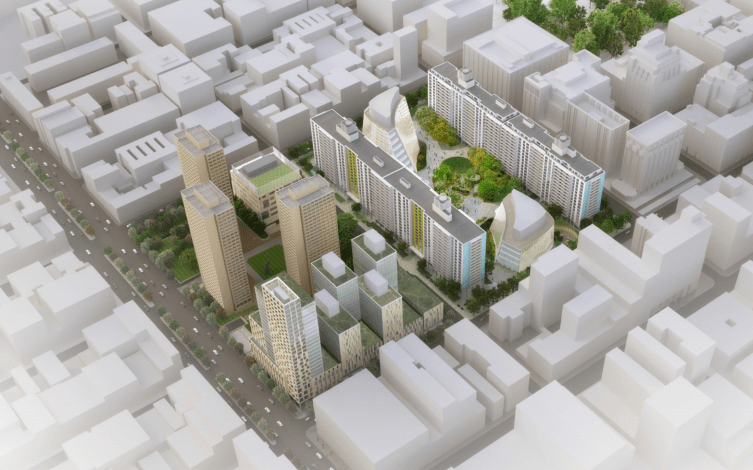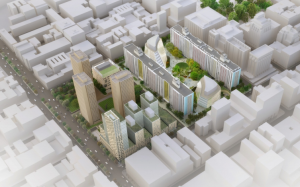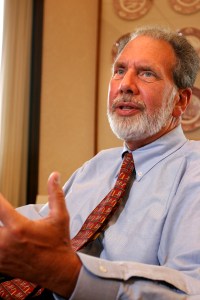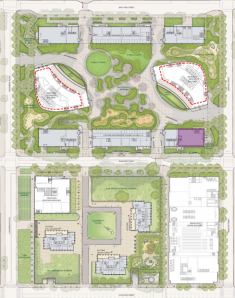NYU President, Opponents Clash Ahead of Lawsuit Appeal
By Tobias Salinger September 17, 2014 4:10 pm
reprints

A week before the city and opponents of New York University’s 1.9-million-square-foot expansion plans in Greenwich Village will make oral arguments in court, NYU President John Sexton reaffirmed the vision behind the four buildings of classrooms, offices and dorms slated for a site bound by LaGuardia Place, Houston Street, Mercer Street and West 3rd Street south of Washington Square Park.
Manhattan State Supreme Court Judge Donna Mills ruled in January that part of the university’s designs for the two “superblocks” require approval from the State Legislature due to its use of land currently occupied by playgrounds and open spaces that have, in effect, become public parks. But the city is appealing the decision, and NYU’s president spoke to an audience of construction, design and real estate industry representatives this morning even as his adversaries seek to block the university from starting construction on a 980,000-square-foot building that’s not on the sites in question.
“The building that we’re doing in the Village is not in Jane Jacobs’ village,” Mr. Sexton said, referencing the journalist and activist who once mobilized community opposition to foil Robert Moses’ plans to build a highway through the area. “It’s done thoughtfully because we are eco-systemic to the Village and to the City.”
Only a third of the 6 million additional square feet the school seeks to build in the city over the next 25 years in the city would rise from the Village, Mr. Sexton noted, casting the school’s expansion plans as essential to maintaining the city’s competitiveness and stature. The first building in the project the City Council approved in July 2012 will include a base and six towers with student and faculty housing, a supermarket, academic facilities and a below-grade gymnasium to replace the James S. Coles Sports & Recreation Center that’s currently on the site, according to court documents. But opponents of the plan, a group that includes members of the faculty, community organizations, preservation groups and elected officials, question whether the university can even proceed with the initial structure after the court’s decision, said Mark Crispin Miller, a media professor and a leader with NYU Faculty Against the Sexton Plan.

“We’ve been listening to such flights of gibberish for three years; it’s remarkable to me that he’s continued to promote the plan with those kinds of statements, which are baffling to say the least,” Mr. Miller said, noting that 39 of the university’s academic departments and divisions have passed resolutions against the plan. “We’re not talking about a bunch of wild-eyed Marxists here. The faculty opposes the plan because it has no academic rationale and it’s financially risky.”
Mr. Miller’s organization and a larger coalition pressed a lawsuit against the city in September 2012. Justice Mills ruled that the University must seek state approval because land like the playground and open space areas spread over three of four parcels currently owned by the city Department of Transportation “may become parkland by implication even, for example, where the land remains mapped for another purpose, as here.” That ruling should put the whole project on hold, said Randy Mastro, a litigation partner at the Gibson Dunn law firm who is spearheading the legal fight against the construction.
“No amount of spin can change the fact that NYU’s proposed development is predicated on the illegal alienation of public parkland,” Mr. Mastro wrote in an email. “That’s why the trial court enjoined it, and that’s why NYU has to go back to square one.”
But the university contends it has the right to break ground on the building already. The construction would help the university address its needs for additional space while also benefitting the city, said NYU spokesman John Beckman.
“The reality is that the lower court specifically held that NYU and the City properly followed all the rules, rejected the petitioners’ demand to restart the process, permitted NYU to proceed with its first planned project, and dismissed five of the six claims made by the petitioners,” Mr. Beckman said in a prepared statement. “We look forward to making the case to the Appellate Division that on the one outstanding issue — the lower court’s holding that some of the DOT strips should be treated as parkland — the court was in error. We believe we have the facts, the law, and public policy on our side.”
A spokesman for the city Law Department, which will be pressing NYU alum and current Mayor Bill de Blasio’s administration’s appeal against Judge Mills’ decision during next week’s oral arguments, said, “We look forward to addressing the merits of this important project to the Court.”

But officials with the New York Building Congress hailed the planned construction at the event this morning as part of a report released today by the group promoting the real estate, design and construction industries. The development represents just one project by the city’s higher learning institutions that will add up to a collective $10 billion construction investment by the city’s 105 colleges and universities over the next five years, according to the report. And the group’s president, Robert Anderson, expressed support for the university’s plans before Mr. Sexton spoke this morning.
“He has done a terrific job of heading this fine university,” said Mr. Anderson, who noted “a couple of academics” oppose the construction plans. “We think we’re building for the academics but sometimes they say, ‘Why are you building for us?’”


